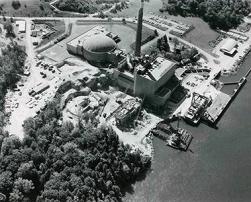SRA’s Energy Analyst, John Busby when writing “Geriatric Design Assessment” (in which he reviewed the so-called “ageing management” of pressure and boiling water reactors) was concerned that the addition of boric acid to the spent fuel pools would lead to the production of radioactive tritium (an isotope of hydrogen) and that this would cause them to leak. Subsequent to the publishing of the article it turns out that in many cases spent fuel ponds and also reactor pipework has leaked and led to major groundwater contamination.
 In
the United States:
In
the United States:
At Indian Point on the Hudson River two spent fuel ponds leaked over a number of years. Tritium, strontium-90 and nickel-63 was detected in the drains and in fish, but it was concluded that the levels were not of concern.
Tritium leaks from spent fuel ponds were detected at Salem, Byron and at Haddam Neck.
Tritium leaks from underground piping were found at Dresden.
http://www.nrc.gov/reading-rm/doc-collections/gen-comm/info-notices/2006/in200613.pdf
In Italy:
Strontium-90 in an upper water table was discovered after thin cracks appeared in the spent fuel pool wall of a research reactor at Eurex. The complex remedial work is described on:
http://www.euronuclear.org/e-news/e-news-21/eurex.htm
Duplicate Spent fuel pools
The last spent fuel from a Generation III reactor is expected to remain in the pool for ten years. If an operational life of 60 years is achieved, then the interior of a pool cannot be accessed for perhaps 70 years and the article recommends that a duplicate pool be accommodated in the pool annex (which should remain empty until required).